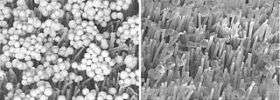Engineers create new gecko-like adhesive that shakes off dirt

(PhysOrg.com) -- Researchers at the University of California, Berkeley, are continuing their march toward creating a synthetic, gecko-like adhesive, one sticky step at a time. Their latest milestone is the first adhesive that cleans itself after each use without the need for water or chemicals, much like the remarkable hairs found on the gecko lizard's toes.
"It brings us closer to being able to build truly all-terrain robots, which will in the future be able to scamper up walls and across ceilings in everyday environments rather than only on clean glass," said Ron Fearing, UC Berkeley professor of electrical engineering and computer sciences and head of the research team developing the new material. "We can envision robots being able to go anywhere they are needed, perhaps in the search for survivors after a disaster."
The adhesive's development is reported online today in Langmuir, a peer-reviewed journal of the American Chemical Society that covers a wide range of topics, including surface properties, nanostructures and biomimetic materials.
For years, scientists have been trying to develop a man-made version of the toe hairs that make the lizard's acrobatic feats possible. Earlier this year, Fearing's group developed another gecko-inspired adhesive using polymer microfibers that could easily attach to and detach from clean surfaces.
But researchers said replicating the gecko's ability to walk through dirty surfaces yet keep its feet clean enough to climb walls has been tricky. In 2005, research led by Kellar Autumn, associate professor of biology at Lewis & Clark College in Portland, Ore., and one of the nation's leading experts on gecko biomechanics, revealed for the first time that a gecko keeps its feet sticky but clean by shedding dirt particles with every step.
"It goes completely against our everyday experience with sticky tapes, which are 'magnets' for dirt and can't be reused," said Fearing. "With our gecko adhesive, we have been able to create the first material that is adhesive and yet cleans itself a little bit with every contact."
In the new study, supported by the National Science Foundation, the UC Berkeley researchers designed the adhesive with microfibers made from stiff polymers. Using microspheres that were 3 to 10 micrometers in diameter to simulate contaminants, the researchers were able to show that the microfibers pushed the microsphere particles toward the fiber tips when the adhesive was not in contact with a surface.
When the fibers were pressed against a smooth surface, the contaminants made greater contact with the surface than with the fibers. Since adhesion strength is proportional to contact area, the microsphere particles preferentially adhered to the glass rather than to the synthetic gecko fibers.
With each simulated step, designed to provide a force similar to a gecko's step, more and more microspheres were deposited onto the surface. After 30 simulated steps, the adhesive shed about 60 percent of the smaller-sized contaminants onto the glass surface.
"This new material likes to adhere to surfaces, but it does not like to collect dirt particles," said Jongho Lee, UC Berkeley graduate student in mechanical engineering and lead author of the new study. "We were able to recover one-third of the shear adhesion strength of clean samples after multiple steps."
The larger contaminants were harder to shake off because they contact a larger number of fibers, and then adhere better to the fibers than to the glass. The researchers said that to resolve this challenge, they will need to understand more features of the gecko toe, such as whether the size of the gaps between bundles of toe hairs helps remove dirt.
Fearing said the next phase of the research will focus on achieving adhesion over rough surfaces.
Source: University of California - Berkeley
















